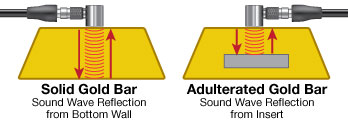With the price of gold soaring, counterfeit gold bars have become a problem for the precious metals industry. Modern fakes can look and feel just like the real thing, and identifying fake gold bullion is challenging if you don’t have the right tools. We’ve developed a two-step solution to detect fake gold bars that’s quick and easy.
Step 1:
Test the outside of the gold bar with an X-ray fluorescence (XRF) analyzer. XRF will determine the purity of the gold bar by directly measuring gold and trace elements including silver, copper, nickel, platinum, palladium, iridium, and any other elements commonly alloyed with gold. Our analyzer’s easy-to-use software can display the gold percentage, karat, or fineness. The Plate Alert feature notifies the user if gold plating may be present.
Step 2:
Test the entire thickness of the gold bar to help ensure it’s “real” throughout with our ultrasonic testing (UT) instruments. High-quality fakes might have real gold on the outside, but might be filled with a cheaper metal inside. Ultrasonic waves traveling through any medium will continue propagating in the same direction until they strike a boundary with a different material. Reflections coming from inside a gold bar, rather than the opposite surface, change the pattern and indicate either an insert of another metal or an internal void.

Our XRF and UT technologies can help reduce your risk of inadvertently buying or selling fake gold bars. For more information, check out these resources:
Nondestructive Precious Metals Assay and Karat ID
Ultrasonic Testing of Gold Bars
EPOCH 650 Ultrasonic Flaw Detector
Get In Touch

